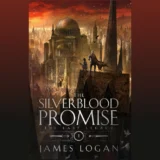
I hope everyone is having a great 2014 so far! Yesterday was my birthday; we celebrated by going to see Peter Jackson’s (and a little bit of J.R.R. Tolkien’s) The Hobbit: The Desolation of Smaug. Since everyone and his or her cousin has reviewed this movie, I won’t review it except to say that as far as Tolkien adaptations go it’s not bad, though I wish Jackson had just made two movies out of the Hobbit—after all, there’s too much to make a really detailed single movie, as Rankin-Bass proved. If you’ve never seen that one, you can catch it on YouTube. It has rather too much Glenn Yarborough singing in it, although at least one of the songs is actually—like in Jackson’s Hobbit movie—made with Tolkien’s own words. But anyway….
In last week’s blurb on FaceBook about this column, Steve Davidson put an exclamation point (!) after Dan Dare’s name, so I think this week I should talk about The Eagle—a British boys’ weekly newspaper in the ‘50s through 1969. As I said last week, we moved to England when I was very young; probably four years old (1951), and in a very short time, I was an Eagle reader; one of the few books I retain from that period was my Eagle Annual No. 3, a hardcover book that reprinted key parts of that year’s (1952) Eagle, though it is in terrible shape. It was one of the books I used when I (mostly) taught myself to read at around age 5 or 6. (I have since bought nice, clean copies of the Eagle Annuals for 1950-1956 off eBay. My “inner child” is very happy about that!)
As shown in the title splash, Eagle number one came out in April 1950; it immediately sold nearly a million copies. By the time we’d moved to Aldeburgh (renowned as the home of Benjamin Britten, England’s premier composer), it was well established. It was a tabloid-sized newspaper, about 10 1/2” by nearly 15” tall. I’m not sure exactly when I became a fan, but it was probably in 1951, because that’s about when I started reading. Because of its size and disposability, we didn’t keep any when we moved back to the U.S. in 1954 or thereabouts—I’m unsure of the dates, because many of my younger years are a closed book to me (My mother claimed to be able to remember her entire childhood in great detail back to when she was a babe in arms. Me, I have a great memory for trivia, but not good at all for personal stuff.) but I did have my yearbook. Because my father was in the Air Force, we moved around a lot. When you’re young and move constantly every few years, your closest friends are often books, and so it was with me.

Despite the colour cover, half the pages were in black and white; for economic reasons, I suppose. During the first year the Eagle varied from 16 pages to 20 pages in length, but soon settled at 16 pages, with pages 1 and 2, 7, the centre spread of 8 and 9, 10, 15 and 16 being in colour, the rest in b/w; the centre spread was usually a cutaway drawing explaining how something worked—usually something like a locomotive or a race car or a power-generating facility—taking advantage of the double width of the centre pages. Contents included—starting with Dan Dare on pages 1 and 2—short stories, other comic strips both b/w and colour—quizzes, sports news and tutorials (about racing, cricket, football (English football, which we call “soccer” in North America), and so on.
The other strips we loved were the Adventures of P.C. 49 (P.C. being a Police Constable) and his little gang of pre-teen “irregulars”; Jeff Arnold in Riders of the Range, a western; Harris Tweed, bumbling “agent” who somehow came out all right in the end; “Tough” Luck of the Legion, about a French Foreign Legion soldat and his brother troopers; and usually an historical and/or inspirational strip, like Headlines of the Past, or Ships of the Ages; also humorous strips like Skippy the Kangaroo. There were also non-continuing humour strips, like Chicko. Unlike American comic books and strips, which used the familiar 4-color process mostly in flat, two-dimensional colour, the strips appearing in the Eagle were all well shaded and coloured, even though printed on reasonably cheap newsprint. All this for 3 pennies (3p)!
Okay, by 1953 it was up to 4 1/2 p (fourpence ha’penny), which was probably—considering that a pound (240 p) was then worth about $3 U.S.—worth a dime or so in US money. (Before decimalization in 1971, the British pound, measured in pounds, shillings and pence—£, s, d— was two sixpences to the shilling, twenty shillings to the pound. And the names of the currency came from Roman occupation back in the old days: Libra, solidus and denarius.) So at first the paper cost half a sixpence (3d) but then eventually rose to 4 1/2d by the time we left England.

But the main reason everyone read The Eagle was Dan Dare. Dan Dare was so popular that even after his creator, Frank Hampson, died, they kept reviving him—first in the pages of the revived Eagle (it was revived in 1982 and lasted that time until 1994, according to Wikipedia), then in his own comic book and, finally (as of this writing) he’s being produced in the old Eagle style by (I assume) fans who have hired artists who used to work on the old strip. (Hampson had, in his heyday, a team of about five artists under his command, so to speak.)

Hampson was a meticulous artist, both in drawing and in research; if something appeared in Dan Dare you could bet it was well thought out before it saw daylight. Despite the small size of the panels, Hampson put in an enormous amount of detail; he said in an interview that “[When] … the reader comes to the story a second time… he can study the pictorial sub plot, and enjoy looking for and finding details, inventions, concepts, ideas, artefacts and hardware, put there to add interest. These details, often tiny, also help make venue, characters and story more authentic.” He also tried to make the science in the strip compatible with what was then known about our solar system.
In the 1950s, very little was actually known about the other planets in our solar system—even our own moon. This was about ten years before the Mariner voyages gave us our first close-up pictures of Mars, and even before the other Mariner space shots gave us real information on Venus—and almost twenty years before we landed a man on the moon! So we could believe that there were canals on Mars, or a lost civilization that died when Mars dried up; or Venus could, under its cloud cover, have alien cultures and civilizations; at least Hampson’s Venus wasn’t as water-logged as most popular SF books had it at the time. (According to Wikipedia, Arthur C. Clarke was science advisor for the first strip—meaning the whole Venus story arc, I presume.) And many years Before Spock, Hampson’s Treens were an unemotional green-skinned alien “race.” Hampson posited that Venus was home to several different peoples: the Treens, green-skinned and reptilian, led by the evil Mekon; the Atlantines, blue-skinned humans who had originated on Earth back in the distant past, and so on.

Dan Dare’s continuing cast of characters included Dan himself, a colonel in the Interplanetary Spacefleet (and its chief pilot) who, unlike American comic heroes, had a very distinctive face: he had a long chin and odd eyebrows that curled at the ends. He was always accompanied by his batman (kind of a personal servant-type) a Northerner (from near Liverpool) named Digby, who was fond of saying “Oo” and “Ee”; Digby was a rotund little guy who was fond of his food and of doing as little work as possible, but he never gave up. They were under the command of Sir Hubert Guest, who was in charge of the space fleet and a pilot himself. Hampson said that Dan Dare is who he would have liked to be, but Digby was more what he was like. Sir Hubert was based—at least in looks—on Hampson’s father. Other continuing characters included Professor Peabody (!), who was a woman, and Sondar, a Treen who became friends with Dan and Digby after Dan saved his life—he learned not to ignore his emotions and, when the UN eventually took over Venus, Sondar was appointed Governor of the Northern Venus Territory. And then there was The Mekon, who was a pure villain with—as far as I can tell—no redeeming qualities. The Mekon was to be a continuing villain right up to the present; I’ve only seen one of the revived Dan Dares, but they look and feel much like Hampson’s work.
Each story arc for Dan Dare took about a year, at two pages a week. The first arc was all about Venus; the second was “The Red Moon Mystery,” which took place on Mars. The third arc, “Marooned on Mercury,” started in August 1953. One thing we might find a bit funny at this date is that in the early ‘50s, British writers assumed that Britain (and the remnants of The Empire) would take first place in the coming exploration of space; you can see it in the early writings of Clarke and others—with the rocket bases being in, for example, Woomera in Australia. In actuality, the Soviets were pretty much ahead of everyone, sending probes first to the Moon, then Mars, then Venus before anyone else did; in addition, they sent animals into space before anyone in the Western world did. (Anyone remember Laika the dog? America responded with Ham, the chimp; I don’t think things ended well for either animal.)
In 1959, in spite of raised prices and a circulation that had to be in the millions, The Eagle’s publisher sold the mag; Hampson soon left the Eagle and Dan Dare. Although other artists took up the challenge, like Frank Bellamy—changing the entire look and feel of the strip—the Eagle itself died in 1969—to be revived in the ’80s for some years. Although Dan Dare was revived outside the Eagle, most notably in the comic 2000 AD (home of Judge Dredd), his character, his appearance and everything else underwent serious change, and he was never as popular as the old Hampson strips. My theory on this is that there was a certain innocence to the old strips, with a hero who was a hero: Dan Dare never lied, and although he was expert in jiu jitsu, preferred to use his wits rather than force to resolve a situation. The newer versions were seldom drawn as well, and usually had a darker character in Dan; more often than not, the stories were a lot like today’s SF movies, relying more on CGI than on character—in the later Dan Dares, the fights replaced the character arcs.
Should you be interested in learning more about Dan Dare, you can buy either single Eagle books or annuals online—I’ve gotten most of mine on eBay from British or Australian vendors; in addition, you might find a DVD collection, probably not legal, but still being sold privately, of the old Eagles. Wikipedia has some good links, including one to the new strip, Spaceship Away, which is apparently being produced—albeit irregularly—with the blessings of the copyright holders.
I’d love to hear your opinions on this column; you can either comment here on the Amazing Stories website—if you’re registered, but registration only takes a few seconds—or on Facebook, where I also post a link in several fan groups. My opinion is only mine and does not necessarily reflect the views of Amazing Stories. I plan to talk more nostalgia, so see you next week!











Dan Dare was a huge hit because the artwork was immaculate. The artists took photographs of the office staff at Eagle to make sure that the poses in their illustrations were accurate.
The artwork had to be good because Eagle was created with a particular mission in mind. The magazine was founded by priests who were concerned at the perceived corrupting influence of US horror comics, which were slowly making their presence felt in the UK market. Dan Dare was designed to be a wholesome counterpart to these 1950s comics from across the pond. I imagine they were worried about things like the EC titles Tales from the Crypt.
A year or so back, I did a blog on DD too and you can see his changing face here: https://alastairsavage.wordpress.com/2012/09/27/dan-dare-british-sci-fis-sleeping-giant/
The Mekon remains in my opinion, the best villain ever to come out of British comics.